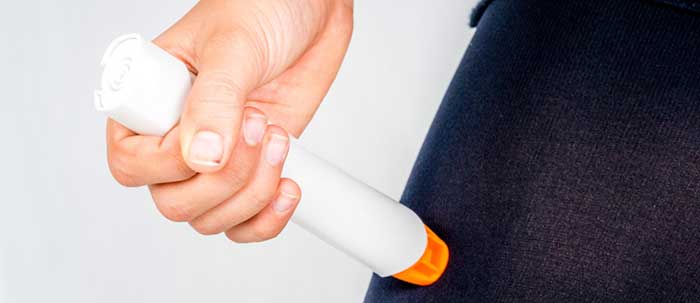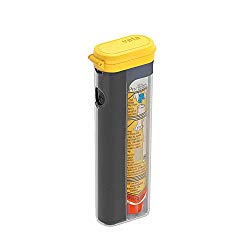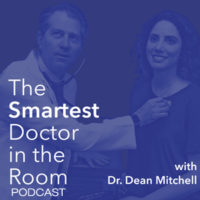Life Without an EpiPen – What Would That be Like?
CONNECT WITH US:
[updated April 2024]

Researchers estimate that 32 million Americans have food allergies, including 5.6 million children under age 18. That’s one in 13 children or roughly two in every classroom suffering from a food allergy. And allergies are only becoming more prevalent. The Centers for Disease Control and Prevention report that the prevalence of food allergy in children increased by 50% between 1997 and 2011. Between 1997 and 2008, the prevalence of peanut or tree nut allergy appears to have more than tripled in U.S. children.
Food Allergy Reactions are Serious (and Possibly Life-Threatening)
According to Food Allergy Research and Education, or FARE, and The Journal of Allergy and Clinical Immunology below are some shocking statistics related to food allergies.
- Every three minutes, a food allergy reaction sends someone to the emergency room.
- Each year in the U.S., 200,000 people require emergency medical care for allergic reactions to food.
- Approximately 8% of children in the United States have a food allergy
- Childhood hospitalizations for food allergy tripled between the late 1990s and the mid-2000s.
- More than 40 percent of children with food allergies have experienced a severe allergic reaction such as anaphylaxis.
- Studies of self-reported reactions show that 16% to 18% of children with food allergy have experienced an allergic reaction while at school or daycare.
- Medical procedures to treat anaphylaxis resulting from food allergy increased by 380 percent between 2007 and 2016.
Studies suggest that food allergies are resolving more slowly than previously believed which leads to a greater prevalence of school-aged children at risk for allergic reactions.
Exciting New Treatment For Anyone Suffering from Food Allergies
What if I told you that the days of fearing food allergies could be over? It might sound too good to be true, but recently there has been a groundbreaking moment in medical history. The first-ever drug approved for any type of food allergy has emerged – Xolair. Join me as we dive into the fascinating journey of this game-changing medication and explore its potential to transform the lives of millions. By combining it with innovative immunotherapy methods like sublingual allergy drops, we’re paving the path towards long-term protection against food allergies.
Anaphylaxis and EpiPens
The medical name for allergic shock is anaphylaxis (ana-filaxis) and it can be a deadly form of an allergic reaction. Anaphylaxis used to be most commonly associated with bee stings but today, food allergies are a much more common cause of this serious reaction.
For anyone with a severe allergy, I have to advise having an EpiPen on hand to self-treat if they come into contact with their allergen. An EpiPen looks like a big pen, but it contains epinephrine (adrenalin) in an injectable form, which can reverse a severe allergic reaction within minutes.
Food Allergies and the Reliance on EpiPens
Did you know that while severe or fatal reactions can happen at any age, teenagers and young adults with food allergies are at the highest risk of fatal food-induced anaphylaxis with most fatal food allergy reactions triggered by food consumed outside the home?
While avoidance has been the best way to “manage” food allergies, it’s not an ideal way to live with food allergies because you can’t control the food in every environment you or your child encounters.
EpiPens are the most commonly prescribed form of injectable epinephrine used to treat a severe food allergy reaction. Thousands of children with food allergies carry their EpiPens in the knapsack or fanny pack to use in case of an emergency because without it they could face a fatal reaction to the food they are allergic to. But one problem with EpiPen as a life-saving device is the fact that we are hitting the 1-year mark in the ongoing EpiPen shortage.
What Would Life Be Like for These Children If They Didn’t Have to Worry If They Forgot Their EpiPen at Home?
If you didn’t have to worry about your child having a life-threatening reaction if they accidentally came into contact with peanuts or ate food that contained dairy? If you were able to relax when they went to school, on play-dates or just out into the world in general because their allergy was no longer life-threatening?
Well, the time has finally arrived when children and parents can start to think about a life where not having your EpiPen won’t put you in a panic. Where contact or ingestion of certain foods won’t put you at risk of having a fatal reaction.
Sublingual Food Allergy Drops – A New Way to Treat Dangerous Food Allergies
On my podcast, The Smartest Doctor in the Room, I interviewed Dr. Mary Morris of Lacrosse Allergy Associates who has been using sublingual food allergy drops for over 3 decades with excellent results to treat food allergies in a similar way to how we use them to treat the pet and environmental allergies. Dr. Morris and her father, Dr. David Morris pioneered the use of sublingual drops for food allergies. Dr. Mary Morris then went to top university medical centers with her results and pleaded with them to conduct research trials proving to the medical community that this treatment works.
Finally, top medical centers such as Duke and now the University of North Carolina have published studies showing that sublingual drops for foods such as peanut, milk, and egg can give children significant protection to foods they were highly allergic to.
Dr. Edwin Kim, MD, MS, originally at Duke and now at UNC as an Allergist and an Assistant Professor of Medicine in the Division of Rheumatology, Allergy, and Immunology, and the Thurston Arthritis Research Center has published impressive studies showing with peanut allergy the following:
After 1 year of sublingual drops to peanut where a dose of 3mg maintenance is reached, a peanut-allergic child can tolerate 4 peanuts( equivalent to 1200mg of peanut protein); after 3 years some of the children were able to tolerate 9 peanuts. This is truly remarkable! In the study after thousands of doses, none of the children in the study needed to have an epinephrine injection from an adverse reaction- equally impressive.
You may hear on the news that pharmaceutical companies are trying to develop treatments for food allergies. One of them is a skin patch with the peanut allergen called Viaskin. It is in research trials now, but probably years away from everyday use.
Food Allergy Reaction in the Hamptons
A Great Example and True Story of Why Reliance on an EpiPen Shouldn’t Be the Answer for Food Allergies
When people think of The Hamptons they think of beautiful beaches, cool stores, and the “in-crowd.” I don’t feel I fit into the last part, but it is lovely on a hot summer weekend to enjoy the first two. I was invited by my wife to stay at a friend’s home in Southhampton and had a lovely time.
Getting ready for the ride home, we stopped in town at a coffee shop for snacks and drinks for the ride home. While waiting in the long line, my wife, who is also a doctor, tapped me on the shoulder and said, “It looks like someone outside the coffee shop is in distress.” So I quickly went from vacation mode to doctor mode as I rushed outside to check out the person in distress – a young girl.
I approached the young girl, a 15-year-old named Hannah, and introduced myself as a doctor. I asked her what happened as she was sobbing and flushed. She said, “I just ate a muffin in the store and I think it has walnuts in it. I’m allergic to walnuts.”
I immediately asked if she had an EpiPen on her – which she did not. I quickly shouted out to the crowd gathering around me to see if anyone knew where the closest pharmacy was located. Fortunately, the closest pharmacy was a CVS only a block away. I left Hannah with my wife and ran in my flip-flops to the CVS. I charged through the doors to the back where the pharmacy was located. At the counter, I shouted, “I’m a doctor and I need an EpiPen for a girl having an allergic reaction.” The pharmacist immediately dropped what he was doing and grabbed an EpiPen. I gave them my medical license number and tossed my credit card on the counter to pay for it and said I would come back later to pick it up.
I ran back to Hannah who was still flushed but more composed. Someone in the crowd had given her Benadryl which reduced some of her throat itchings. By now the police had arrived and the EMS. They took over and transported Hannah to the local hospital for evaluation and monitoring.
I left Hannah my cell number so she could call me if she felt worse later; my wife spoke to her mom on the phone and told her everything would be fine. The whole episode worked out for the best but it got me thinking:
Hannah was fortunate that myself and my wife, two doctors – one of us an allergist, were on site when she had an allergic food reaction. But what about the other children that aren’t as fortunate?
Dr. Mitchell’s Tips to be Safe if an Allergic Reaction Occurs
- Be careful when you are outside of your home eating. Whenever possible buy packaged foods with clear labels versus unlabeled foods.
- Don’t forget your EpiPen whenever you are traveling – too many fatalities occur with food allergies when a person with a known food allergy didn’t have an EpiPen on them and it took too much time for help to arrive. Products like America’s Veta Smart Case & App for Your EpiPen Auto-Injector are great for helping you remember to take your EpiPen, know where it is at all times and for parents know when you child has to use their EpiPen.
- Keep some form of ID that identifies you as someone with food allergies. For example, individuals with bee sting allergies used to have bracelets that let people know about their allergy. These bracelets could save your life or the life of your child.
- A holistic approach to preventing a food allergy reaction involves baking soda or sodium bicarbonate tablets. If taken before a meal they change the pH in the stomach and can block in some cases an allergic reaction.
My final recommendation is for any child or adult with a dangerous food allergy to consider desensitization to the food or foods they are allergic to. With FDA approval, we have a fantastic combination treatment at Mitchell Medical Group to help anyone suffering from dangerous food allergies = XOLAIR + sublingual food allergy drops.
It’s not widely known, but sublingual allergy drops can build up immune tolerance to the food you are allergic to, such as peanuts, tree nuts, egg, milk, shellfish or any food.
At Mitchell Medical Group, we are taking the lead in New York to provide sublingual allergy drops to our food allergy patients that live in fear of accidental ingestion of the food they are allergic to. We want people who suffer from food allergies to have more peace of mind and be protected from a severe allergic reaction. I predicted this day would come 12 years ago when I wrote my book, Dr. Dean Mitchell’s Allergy and Asthma Solution: The Ultimate Program for Reversing Your Symptoms One Drop at a Time – it’s been a long time waiting for this to happen.
I can’t wait for the day for a food allergy patient (if they exist in the future) to say: “ What was an Epipen?”- that would be a beautiful moment.
– Dr. Dean Mitchell, M.D.
About the Author – Dr. Dean Mitchell, M.D.
Dr. Dean Mitchell, M.D. is a Board Certified Allergist and Immunologist based out of NYC. He graduated from the Sackler School of Medicine and completed training at the Robert Cooke Allergy Institute in New York City. He is also a Clinical Assistant Professor at Touro College of Osteopathic Medicine, a fellow of the American Academy of Allergy, Asthma, and Immunology, and the author of Dr. Dean Mitchell’s Allergy and Asthma Solution: The Ultimate Program for Reversing Your Symptoms One Drop at a Time. Dr. Dean Mitchell, M.D. has also been featured in The New York Times, The Huffington Post, Fitness Magazine, Dr. Oz and News NY 1. Dr. Mitchell also hosts the podcast The Smartest Doctor in the Room – a combination of a lively, personal and in-depth interview with top healthcare specialists.
This site contains affiliate links to products. We may receive a commission for purchases made through these links.
References:
Facts and Statistics, Food Allergy Research and Education (FARE). https://www.foodallergy.org/life-with-food-allergies/food-allergy-101/facts-and-statistics
Sicherer SH. self-injectable epinephrine: One size does not fit all(Editorial). Ann Allergy Asthma Immunol 2001; 86:597-8. https://www.annallergy.org/article/S1081-1206(16)31402-8/abstract
Sicherer SH, Furlong TJ, Desimone J, Sampson SH. Peanut allergic reactions in schools. J Pediatr 2001; 138:56-65. https://www.ncbi.nlm.nih.gov/pubmed/11295721
Fleisher DM, Burks AW, Vickery BP, et al. Sublingual immunotherapy for peanut allergy: A randomized, double-blinded, placebo-controlled multicenter trial. J Allergy Clin Immunol 2013; 131: 119-127. https://www.ncbi.nlm.nih.gov/pubmed/23265698
Dr. Dean Mitchell’s Allergy and Asthma Solution, Dean Mitchell MD. Marlowe and Company, 2006. Dr. Dean Mitchell’s Allergy and Asthma Solution: The Ultimate Program for Reversing Your Symptoms One Drop at a Time



